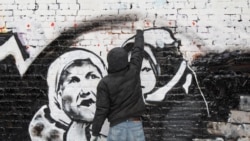Rising Russian street artist P183 has reportedly died.
The producing company Teatralnoe Delo, which had hired him to create sets for a rock musical, released a statement on April 3 saying the artist passed away on April 1.
It gave no details on the cause of death. The Russian press, however, quoted sources as saying he had either hanged himself or died of poisoning.
Little is known about P183, who is also known as Pasha 183, except that he was 29 and studied "communicative design" at university. His real name is rumored to have been Pavel Pukhov.
The elusive artist carefully preserved his anonymity, working only at night and appearing in his rare media interviews wearing a black balaclava.
His eye-catching graffiti and art installations earned him the nickname of the "Russian Banksy."
P183 himself appeared to reject the comparison, saying he never sought to emulate the world-famous British guerrilla artist.
Instead, he drew inspiration from Russian rock musicians such as Yegor Letov, the founder of the band Grazhdanskaya Oborona (Civil Defense), and Konstantin Kinchev, the frontman of the band Alisa.
P183 would actually have preceded Banksy, painting his first graffiti 15 years ago. He created dozens of thought-provoking murals and street installations, mostly in his native Moscow.
His creations rarely lasted more than a few days before being painted over by the authorities, and he once noted that his politically themed works were particularly short-lived. But photographs of his graffiti art earned him a huge following on the Internet and drew the attention of the mainstream art world.
His giant murals captured with painful accuracy the problems that he believed plague contemporary Russia: poverty, narrow-mindedness, greed.
He often created visual illusions in his work -- using a lamppost to help create a huge pair of reading glasses in the snow, for instance, or using a real flame to depict the flare held by a rioter. Another installation depicted a young girl hanging Christmas decorations on a barbed-wire fence.
P183 saw himself as a social commentator rather than a political activist, although his work at times openly sided with the opposition.
His motivation, he once told Britian's "The Guardian," was to help make Russia a "strong, educated, and cultured" nation.
The producing company Teatralnoe Delo, which had hired him to create sets for a rock musical, released a statement on April 3 saying the artist passed away on April 1.
It gave no details on the cause of death. The Russian press, however, quoted sources as saying he had either hanged himself or died of poisoning.
Little is known about P183, who is also known as Pasha 183, except that he was 29 and studied "communicative design" at university. His real name is rumored to have been Pavel Pukhov.
The elusive artist carefully preserved his anonymity, working only at night and appearing in his rare media interviews wearing a black balaclava.
His eye-catching graffiti and art installations earned him the nickname of the "Russian Banksy."
His giant murals captured with painful accuracy the problems that he believed plague contemporary Russia.
Instead, he drew inspiration from Russian rock musicians such as Yegor Letov, the founder of the band Grazhdanskaya Oborona (Civil Defense), and Konstantin Kinchev, the frontman of the band Alisa.
P183 would actually have preceded Banksy, painting his first graffiti 15 years ago. He created dozens of thought-provoking murals and street installations, mostly in his native Moscow.
His creations rarely lasted more than a few days before being painted over by the authorities, and he once noted that his politically themed works were particularly short-lived. But photographs of his graffiti art earned him a huge following on the Internet and drew the attention of the mainstream art world.
His giant murals captured with painful accuracy the problems that he believed plague contemporary Russia: poverty, narrow-mindedness, greed.
He often created visual illusions in his work -- using a lamppost to help create a huge pair of reading glasses in the snow, for instance, or using a real flame to depict the flare held by a rioter. Another installation depicted a young girl hanging Christmas decorations on a barbed-wire fence.
P183 saw himself as a social commentator rather than a political activist, although his work at times openly sided with the opposition.
His motivation, he once told Britian's "The Guardian," was to help make Russia a "strong, educated, and cultured" nation.










